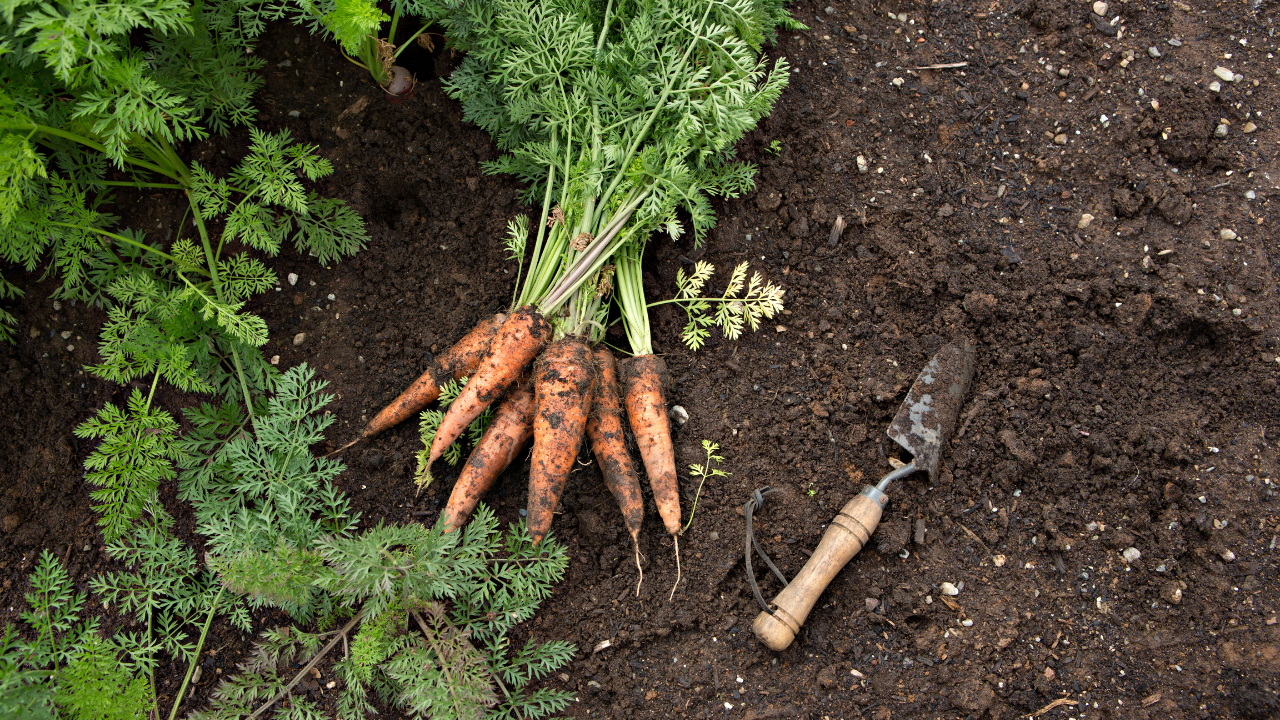
Want to know how to grow carrots from seeds? You’ve come to the right place.
Carrots are some of the easiest vegetables to grow, particularly for gardeners in colder climates. They prefer the chillier weather of early spring and late fall, when daytime temperatures average 75 degrees and those at night are around 55 degrees.
These vegetables can grow even in a small garden bed or a container, making them the perfect candidate for any kind of garden.
Here are some tips on starting your own carrot garden this spring.
Sowing Carrot Seeds

Almost always, it makes more sense to start carrots from seeds sown directly in the garden. That’s because these root vegetables have fine roots that don’t like to be disturbed.
Wait until early spring (a couple of weeks before the last spring frost, as long as the soil can be worked) to plant. Sow seeds in rows about one to two feet apart and half an inch deep. Each individual seed should be one to two inches apart.
It can be difficult to provide this kind of spacing, so you may find that you just have to thin them later on. Once they are about four inches tall, you can thin them to two inches apart.
Where to Grow Carrots
Carrots should be grown in full sunlight, ideally in soil that is sandy and well-draining. Heavy clay soils (as well as those with lots of rock) cause carrots to wind up rough-looking and unattractive.
Because of this, you may want to till up the area where you plan to plant your carrots before you sow any seeds. This will help soften and aerate the ground.
When to Plant Carrots
Carrot seeds can be planted two to three weeks before the last expected frost. You can plant another batch two or three weeks after that, if you choose. Most take about 80 days to mature so you will want to plan accordingly based on your growing zone.
Best Varieties of Carrots to Grow
There are countless types of carrots you can grow in the garden. Some of the most popular options include:
- Deep Purple Hybrid
- Touchon
- Lunar White
- Imperator 58
- Little Fingers
- Parisian Heirloom
- Purple Dragon
- Red
- Solar Yellow
- Tendersweet
- Short ‘n Sweet
- Thumbelina
- Kaleidoscope
Many of these can be found in colors besides orange, such as purple and yellow, while others are better suited to unique environmental conditions (such as warm weather or container growing).
Caring for Carrot Plants

Once your carrot seedlings have emerged, here are some tips to follow to keep them growing strong and healthy.
Watering
Like most other vegetables, carrots need about an inch of water per week. If this doesn’t occur from natural rainfall, you will need to water, making sure you soak the soil completely. If you only water the surface, the roots will fail to develop appropriately.
Fertilizing
Fertilize your carrots prior to planting. Use a balanced fertilizer of 10-20-10 for every 10 feet of rows. Use a rake to mix the fertilizer into the soil.
Pests and Diseases
Carrots tend to be relatively hardy little creatures, but there are still a few pests and diseases you will want to keep an eye out for.
One of the most common diseases to affect carrots is powdery mildew. A fungal disease, it can be prevented by thinning your plants early in the season and providing proper amounts of watering.
When it comes to pests, the most significant one to watch out for is the carrot rust fly. This pest causes long tunnels that become mushy and unpleasant on your carrots. You can keep it away by using row covers to protect your plants. Rotating your crops between seasons and cleaning out the garden after the growing season is done can also help keep these pests away.
Other Considerations
It is important to keep your carrot bed free from weeds, especially when the carrots are small. Leave your carrot beds unweeded, and you will likely find that the weeds draw nutrients away from the carrots, causing them to develop poorly.
How to Grow Carrots in Containers

Carrots can even be grown in containers! You’ll follow the same instructions for planting and care as specified above. However, you may find that you need to water and fertilize more frequently since containers have a tendency to leach nutrients and moisture more quickly.
Otherwise, just choose a container that is about 12 inches deep and a variety of carrot that is well-suited to container growing (usually one that reaches no longer than seven or eight inches).
Harvesting Carrots

Carrots grow continuously after being planted and take very little time to mature. You can start your first crop in the middle of spring and keep planting new crops so that you can have a continuous harvest every few weeks.
You can start harvesting as soon as they are finger size, but most people will wait until the roots have developed more fully (when they are several inches long). Simply pull them up by the tops, making sure you loosen some of the compacted soil around the carrots before you pull so you don’t break them off in the ground.
If you just want to check the size of your carrots before you pull them up, feel free to just brush some dirt off the top of the root and give them a look. Gently lift the carrot from the dirt when you’re ready to harvest.
And if you don’t want to harvest right away, feel free to keep them growing through the winter. In frost-free zones, you can leave carrots in the ground and keep harvesting all winter long. Don’t worry if your carrots take a frost or even a snow - they’ll taste sweeter afterward!
Best Ways to Use Your Fresh Carrots

Carrots are best eaten fresh but there are plenty of other ways to store them for later use, too. You can process them in a pressure canner or slice them and stash them in the freezer. Of course, when eaten fresh, carrots taste best in soups, stir-fries, and casseroles - and let’s not forget everyone’s favorite recipe, carrot cake!
There is no shortage of recipes that you can try when it comes to using fresh carrots - and knowing how to grow carrots on your own is the first step toward always having a consistent, tasty supply!



